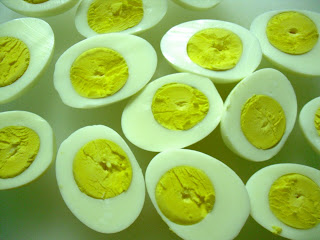I've been sitting on this recipe for a while. When I was in Detroit for Thanksgiving, I went on a Food Network-watching binge. Amidst all the recipes for stuffing and green bean casserole, Tyler Florence’s baked rigatoni with eggplant was a refreshing change of pace. I am not exactly a huge fan of Florence’s show. First of all, the title, “Tyler’s Ultimate,” is a little presumptuous. Who can really claim to be the authority on the ultimate? And the presumption doesn’t stop there: he introduces every recipe as the “ultimate [insert food here].” My favorite is the episode where he makes the “ultimate barbecued ribs,” yet his recipe requires neither a grill, nor a smoker. As far as I’m concerned, at least one of those cooking methods is requisite to “barbecue” ribs. Also, someone should inform Tyler of the fact that he compulsively says, “boom” after every thing he does in the kitchen.
Now that the Tyler-bashing is out of my system, I will admit that he does sometimes prepare some rather appealing recipes. Perhaps I seem to be backpedaling, but please note that said I’m not a huge fan of the show. The recipes may be a different story, and, for the right recipe, I can handle verbal ticks, and cocky attitudes. This eggplant rigatoni is just such a recipe. It consists of soft eggplant, homemade tomato sauce, chunks of chicken sausage, and rigatoni. As if those luscious ingredients weren’t enough to make your eyes bulge, it’s all glued together by melty, stringy cubes of mozzarella cheese. And if you have never made your own tomato sauce, consider this your golden opportunity. The ingredients for tomato sauce are inexpensive, the process is satisfying, and your heart will brim over with pride when you taste it. This recipe will mess up a multiple pots and pans, but it’s worth it. Don’t worry: the time the pasta spends snuggling in the oven is more than enough to tackle those dishes.
I’m sure you’re asking: “Why? Why would an alleged psycho cooker wait over two months to cook and post about something so wonderful?” Well, the truth is I actually made it during finals, but I did not have the time to write it up. Before you get any angrier with me, I must tell you there is an upside to my delayed posting: I have now made this twice. While the first batch was lovely, the second batch was undoubtedly of a higher caliber. The version below has the perfect ratio of sauce-to-pasta, and it’s heavy on the sausage and the eggplant, making it virtually a one-pot meal (of course, an extra green vegetable won’t hurt anyone). Eggplant rigatoni: make it; love it.
Eggplant Rigatoni (adapted from Tyler Florence’s recipe)
Olive oil (plenty of it)
¾ of a pound of raw chicken sausage (about 3 links)
1 onion, diced
2 garlic cloves, minced
1-28 oz. can whole tomatoes including juices, squashed with your hands
2 bay leafs
½ teaspoon crushed red pepper flakes (optional)
Salt and pepper, to taste
¼ cup chopped parsley
1 large eggplant (about 1¼ to 1½ pound), one-inch dice
¾ pound rigatoni
½ pound mozzarella, small dice (10 minutes in the freezer will make chopping easier)
½ cup freshly grated Parmesan cheese
· Put a large pot of water on to boil for the pasta, and preheat the oven to 400 degrees.
· In another pan, heat a drizzle of olive oil in and heat over medium-high to high heat until the pan is very hot. Add sausages and allow to brown on all sides, 4-5 minutes per side. They do not have to be cooked through completely because they will finish cooking in the oven.
· Remove sausages and set aside. Reduce heat to medium and add onions and garlic to the same pan (the moisture from the onion will pick up any brown bits from the sausage). Season with salt, and pepper, and allow to cook for 8-10 minutes, until onion is soft and translucent.
· Add tomatoes, bay leafs and hot pepper flakes. Reduce heat to a simmer, and allow sauce to simmer for at least 15-20 minutes.
· In a large wide pan, heat 3 or 4 tablespoons of olive oil over medium-high heat. Add eggplant. If it doesn’t fit in a single layer, cook it in batches. Allow to brown for 7-8 minutes, but it doesn’t have to be completely cooked through because it will cook more in the oven. Once it is browned, season with salt and pepper.
· Meanwhile, cook rigatoni in boiling water, but take it out a couple of minutes before it is completely cooked through. Reserve ½ - 1 cup cooking water before draining.
· Chop sausages into chunks. Then combine pasta, eggplant, sauce, sausage, parsley, and mozzarella. Add pasta cooking water if the pasta looks dry, a couple tablespoons at a time until it reaches the desired consistency. Transfer to a 9x13 inch baking dish, and top with Parmesan. Bake for 25-30 minutes until bubbly and golden.







































